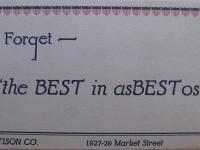Did you know that Ambler used to be the asbestos capital of the world? The appeal of that slogan doesn't really stand the test of time, but if it weren't for the industrial development that came with the Keasbey & Mattison asbestos factory, the borough of Ambler in Montgomery County, Pennsylvania wouldn't be what it is today. We have recently learned a lot about the history of Ambler after visiting two small historical societies that cover the area: the Historical Society of Fort Washington and the Wissahickon Valley Historical Society. A separate blog post about the Wissahickon Valley Historical Society is forthcoming, but I hope they'll forgive me for using an image from their fantastic museum exhibit on "K&B" in this post.
The Keasbey & Mattison Company was founded by wealthy financier Henry G. Keasbey and chemist Dr. Richard V. Mattison in 1873. The company originally focused on pharmaceuticals, and found success with products including their best-seller Bromo Caffeine. After discovering the potential for asbestos insulation, the company shifted their focus to asbestos product development and manufacturing, and moved their factory from Philadelphia to Ambler in 1882.
The company spurred development of the Ambler community in many ways. They built affordable housing for their workers, and helped support a library and opera house in the center of town. In the process of bringing electricity and water to their factory, the company also built up infrastructure for the town to use these utilities. Dr. Keasbey built a palatial estate, Lindenwold, which today is used as a Catholic orphanage, St. Mary's Villa.
K&M helped with war production during World War I, and through some changes in ownership, continued to produce asbestos and related products as Nicolet Industries until 1987. By that point, the health risks surrounding asbestos had hit the news, and asbestos factories were being shut down across the county.
Part of Keasbey & Mattison's story is told in the Edmund E. Plumly scrapbooks, 1960-1981 [bulk 1973-1981]. He worked at the factory as it transitioned to Nicolet, and his albums include photographs of his coworkers and the factory, as well as newspaper clippings on the developing asbestos health controversy. In light of today's knowledge about the health effects of asbestos, it is interesting to notice the tender care that Plumly clearly devoted to constructing his scrapbooks, and the evident nostalgia he still felt for the old plant. The collection will be a true gem to industrial historians.
See all finding aids for the Historical Society of Fort Washington.


